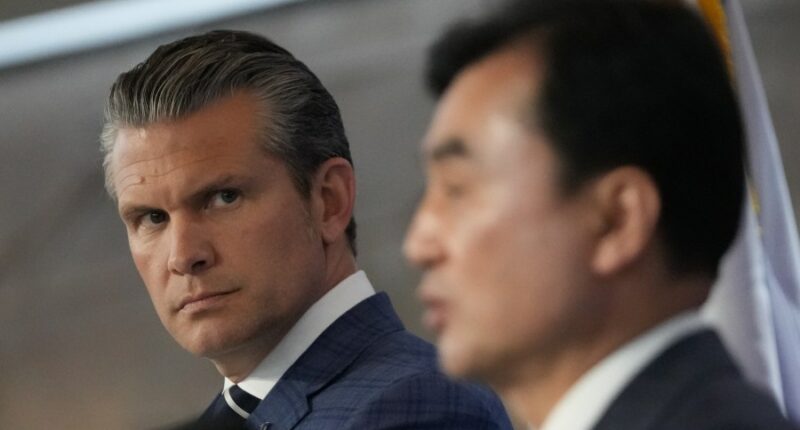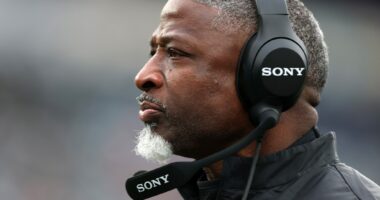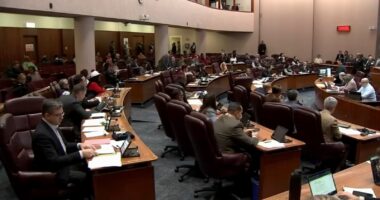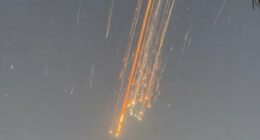Share this @internewscast.com

In a recent address from Seoul, U.S. Defense Secretary Pete Hegseth expressed strong support for South Korea’s decision to increase its military budget. On Tuesday, he emphasized the importance of South Korea taking a more prominent role in self-defense against potential threats from North Korea. This comes as both nations prepare for possible “regional contingencies.”
The longstanding alliance between the United States and South Korea is entering a new phase, with a focus on modernizing defense strategies. The U.S. appears keen on having South Korea bolster its conventional military capabilities, allowing Washington to redirect some of its strategic attention towards China. This shift in focus was a major topic during Hegseth’s discussions with South Korean Defense Minister Ahn Gyu-back.
Following their annual security talks, Hegseth commended South Korea’s dedication to enhancing its defense budget and investing in military advancements. He noted that these investments are crucial for South Korea to lead its conventional deterrence against North Korean threats more effectively.
In a related development, South Korean President Lee Jae Myung addressed parliament, urging approval for an 8.2% increase in defense spending for the coming year. He argued that this boost would aid in modernizing the nation’s military arsenal, thereby reducing its dependency on U.S. support.
Hegseth also underscored the mutual benefits of defense cooperation, particularly in ship maintenance and repair. He praised South Korea’s shipbuilding expertise, which ensures that U.S. naval capabilities remain at peak readiness to handle any crisis.
“Despite the perilous security challenges we face, our alliance is stronger than ever,” remarked Hegseth, reaffirming the robust partnership between the two nations.
‘No daylight or differences’
Hegseth said the South Korea-U.S. alliance is primarily aimed at coping with potential North Korean provocations, but must also keep other regional threats in view.
“There’s no doubt flexibility for regional contingencies is something we would take a look at, but we are focused on standing by our allies here and ensuring the threat of the DPRK is not a threat to the Republic of Korea and certainly continue to extend nuclear deterrence as we have before,” he said.
DPRK stands for the Democratic People’s Republic of Korea — North Korea’s official name — while Republic of Korea is South Korea’s formal name.
In recent years, the U.S. and South Korea have been discussing how to integrate U.S. nuclear weapons and South Korean conventional weapons in various contingencies. South Korea has no nuclear weapons and is under the U.S. “nuclear umbrella” security commitment.
Ahn denied speculation that South Korea could eventually seek its own nuclear weapons program or is pushing for redeployment of U.S. tactical weapon weapons that were removed from South Korea in the 1990s. He stressed that Seoul remains committed to the nuclear non-proliferation treaty.
“Because we cannot have nuclear weapons, a system integrating U.S. nuclear capabilities and South Korea’s conventional weapons, the CNI (conventional-nuclear integration) framework, has been established,” he said.
Hegseth and Ahn did not issue a joint statement after the meeting, leaving the details of their agreements unclear. It’s unusual for the two countries’ defense ministerial talks to end without an immediate joint statement. But Hegseth said there was “no daylight or differences” between the two countries, only “a bigger deal which takes a little bit more time.”
During a separate meeting with Hegseth later Tuesday, Lee reiterated his support of an implementation of a previous agreement to transfer wartime operational control of the allied forces to a binational command led by a South Korean general. Currently, the commander of the 28,500 troops in South Korea has wartime operational control of the allied forces, including the South Korean military.
Lee said South Korea taking greater defense responsibilities on the Korean Peninsula would lessen U.S. military burdens in the region, according to Lee’s office. Many South Koreans view regaining their military’s wartime operational control as a matter of national sovereignty.
North Korean artillery tests before Hegseth’s arrival
North Korea didn’t immediately comment on the Hegseth-Ahn meeting.
South Korea’s Joint Chiefs of Staff said earlier on Tuesday that it detected the North test-firing around 10 rounds of artillery toward its western waters on Monday, shortly before Hegseth arrived at an inter-Korean border village with Ahn to kick off his two-day visit to South Korea.
The joint chiefs said the North also fired the same number of rounds Saturday afternoon, before a summit between Lee and Chinese President Xi Jinping, where Lee called for a stronger role by Beijing to persuade the North to return to dialogue with Washington and Seoul.
North Korea had expressed irritation over the agenda of the Lee-Xi meeting, ridiculing Seoul for clinging to a “pipe dream” that the North would one day give up its nuclear weapons.















